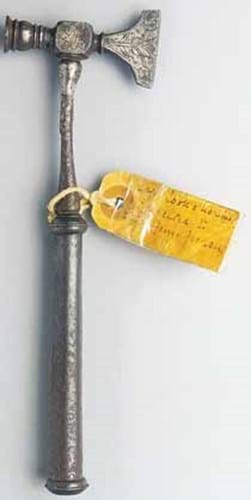
So it will not take a serious historian or exploration enthusiast to recognise the value of a remarkable relic that appeared at Christie's King Street on September 23.
Part of the Travel and Exploration sale, the steel hammer was a gift from Captain James Cook to his friend and patron Sir George Jackson, second secretary to the Admiralty and judge-advocate of the Fleet. A full-length portrait of Sir George by Nathaniel Dance was also in the sale.
Jackson and Cook were contemporaries in the same close-knit Cleveland community and the Jackson family had connections with a number of
significant figures in Cook's early life, including ship owners Walkers of Whitby who gave the young James an apprenticeship at the age of 17.
Jackson himself is thought to have had a hand in Cook's impressive career progress and was influential in the decision to appoint Cook as commander of the Endeavour in 1768. This did not go unappreciated by Cook, for the hammer was not his only gift to Jackson. The great navigator also named Port Jackson (today Sydney Harbour) and Point Jackson in New Zealand after him during his first voyage to Australia.
Made in the late 17th or early 18th century, the cut steel hammer measures 8in (20cm) and is engraved with foliage bands, rosettes and stylised tulips. The brown paper luggage tag tied to the shaft is labelled in ink Captain Cook's hammer, Presented to Sir George Jackson, Exhibited in 1928 at Middlesborough during the Centenary celebrations. This inscription refers to an exhibition at Stewart Park, Marton-in-Cleveland that was held to mark the bi-centenary of Cook's birth. Then the hammer was loaned by Major C. Ward-Jackson (a descendant of Jackson).
However solid the link with Cook, there is much uncertainty as to what exactly the object was used for. It has been suggested that it is a piece of gunnery equipment, a combination tool or perhaps little more than a domestic utensil for chopping up sugar.
What is better known is that tools were essential to the survival of Cook and his crew. His ships were packed with bundles of axes, hatchets, knives, scissors and other items that could be exchanged for food or artefacts with the natives, or given in goodwill to appease sometimes hostile hosts.
Whatever the hammer's purpose, it is thought to have accompanied Cook on his nautical adventures before eventually being presented to Sir George.
Alongside the Dance portrait (that failed to sell), this rare personal relic was consigned to Christie's by Jackson's descendants.
Estimated at £20,000 to £30,000 it was sold to an unnamed bidder for £60,000 (plus 19.5 per cent buyer's premium).




